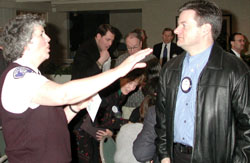|
Preparing for Emergencies
|

Joanne Jordan and Jay Powers
|
Joanne Jordan is some kind of presenter! Over the 16-year history of the BBRC, we’ve seen a lot of presentations. But, 800 presenters later, you’d have to agree that Joanne knows her business and is perhaps one of the most engaging speakers we’ve had the pleasure of hearing! “I used to teach little kids, so I talk fast, and I may not have too much time left to talk about disaster preparedness. Thanks to Rotary for inviting me and to the Salvation Army for the work it does. But, I’m here to talk about disasters.”
Joanne began by tackling earthquake myths: how to be safe. “Getting under doorways is not good advice. Doors hurt people; people get hurt trying to get to the door. It’s not recommended. Injuries to peoples’ limbs are most prevalent. We recommend Drop, Cover & Hold. How to be safe? Drop under a table or desk, cover yourself underneath, and hold on to legs of the table.”
At this point, the microphone took a vacation, but without losing a beat, Joanne switched to “my gym teacher voice. Pay attention or you’ll give me 25!” Don Deasy replied, “In your dreams!”
|

Joanne Jordan and Wendi Fischer
|
Back to disasters. “The goal is to make sure your head is not the tallest thing in a room. When you feel shaking from an earthquake, quickly drop under a table or desk and from underneath your desk, call out to others to drop and cover. Be dominant, call out in a strong voice. People are like deer in the headlights. They first question what is happening and then follow with denial: Is that a truck hitting the building?”
Jordan conducted the What If Game. “I’ve been doing this for 13 years, and 13-year-old boys are the most fatalistic. They come up with the goofiest scenarios. You should all know that earthquakes are the most survivable of all disasters.” So, on to the What If Game.
What if …
… you’re in a place without a table?
Get to an inside wall within the structure.
… you’re in a car or bus?
Pull over, stop, and stay in your car. If you’re on a bridge, slow down and clear the bridge before stopping.
… you’re in bed?
Stay there, pull the pillows and covers over you. As for diving under your bed, “When was the last time you fit under your bed?!” Put shoes and flashlight by your bed. It’s best to stay in wood frame homes. They can take the shaking better than other structures.
… you’re in an open area?
Sit yourself down. The danger zone is the height of the building. We know that high-rise buildings perform very well.
… you’re in the bathroom?
The bathroom is the best place you could possibly be. Taking a shower? Turn the water off and be seated. The sloshing stops when the earthquake stops! Joanne said, “Since Feb 28, 2001, I’ve been the confessional for dozens of bathroom stories!”
… I have small kids?
Noise scares kids and is compounded by the motion. Adult reactions have the biggest impact on kids. How you handle an earthquake will shape their life experience. The Bellevue School system has a fine disaster plan.
Questions and Answers:
Q: What if I’m pumping gas when an earthquake hits?
A: “Turn off nozzle, get in the car, and drive to a safer place.”
Q: What about the safety of bunk beds?
A: “If they’re on an inside wall, the protection offered by the top bunk is ideal. Would be a good idea to eye-bolt the bunks to the walls.” Murphy’s law says ‘wherever you are is where you are.’ In recent earthquakes, we’ve learned that student’s chairs can hold up floors in schools.
Q: Should we worry about trees?
A: “If they can go through snowstorms and windstorms, they can go through an earthquake.”
Q: How about those high shelves in stores?
A: “These tall shelving units should have quake strapping. My office has a vendor’s list available.”
Q: I’m in my seat and it’s the fourth quarter at Husky Stadium. What do I do?
A: “First, are we winning?! Stadium seats are bolted by law. Get down between rows.”
Q: What about an underground parking lot?
A: “If you can get to the elevator core, that’s where there’s heavier construction. If you’re near your car, get in.”
Q: What about the Seattle Fault?
A: “We in Bellevue say, ‘It’s not our fault!’ But, it is an active fault and last had a significant earthquake about 1100 to 1500 years ago, depending on who you talk to!”
When disaster strikes, we all need to be prepared. Jordan asked everyone to take the distributed brochure home. “It’s a great reference.” Things we can do in preparation for any disaster is to stock up on supplies. You should have a three-day supply of food and necessities for you and your family. There is a checklist in the brochure. You should store a gallon of water per person per day. Attend a first aid class and get up to speed. Put your supplies in one place. As far as sanitation goes, “earthquakes usually bring about two human reactions: those who have to go and those who’ve already gone!” We must prepare for earthquakes because our area is rated #3 in the nation for the next big event. The other spots are California #1 and Alaska #2.
For the fine presentation by Joanne Jordan, a donation of 700 pounds of food in her name was made to Rotary First Harvest. Joanne is available to speak to any group in Bellevue, e.g., offices, companies, other organizations. You may contact her at (425) 452-7923.
Thanks to Jenny Andrews for her introduction.
|